The number one challenge I’ve experienced as a double reed music educator has been finding quality affordable instruments for students.
Because this is a challenge (not just for me) but for every double reed beginner and teachers worldwide, over the next few weeks my blog is dedicated to discussions about the best Beginner-Intermediate Oboes, English Horns and Bassoons.
Many parents of beginner musicians will find the money for a flute, a trumpet or trombone at introductory beginning band events. The thought of parting with $500-$1000 is a stretch but most families will find a way to make it work.
For double reed parents finding $3600 for a beginner oboist to start on a Renard 330 is rarely in the family budget, especially when parents fear that music is a phase.
My dream has always been to find beginner double reed instruments that are high quality and available at an affordable price.
Sure! There are instruments less than $2000 on the beginning oboe market but I’ve found that most students outgrow these instruments within 6 months of their oboe journey. The high level of resistance and limited range (due to lack of keys) challenge students from day one in beginning band.
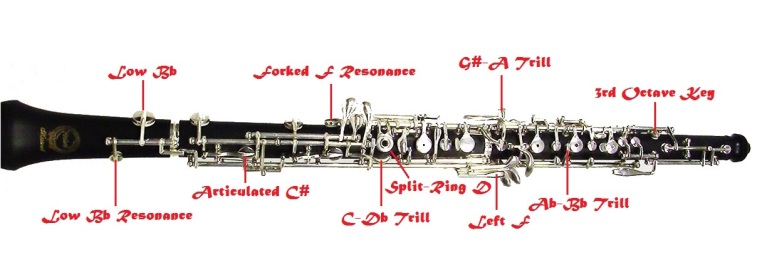
So this year at the International Double Reed Society Conference in Columbus, Georgia- I made it my personal mission to find quality double reed beginner-intermediate instruments.
I knew I wasn’t alone in my dream. During breaks at professional gigs Erica Howard and I would regularly chat about the challenges facing beginning oboists.
I knew that Erica’s background in Instrument Repair, her work as Principal Oboist of the Atlanta Opera and her growing Private Lesson Studio were a perfect fit to in helping me to achieve dream of finding a quality affordable student oboe! It felt natural for us to team up this summer.
And guess what?!? We not only found great beginner-intermediate oboes but English Horns, too! More on English Horns next week.
After viewing and playing many of the instrument options at IDRS we spent most of August continuing our research. Hours were spent making comparisons and speaking with companies so we can offer you discount codes for our new favorite, the Nobel Instruments.
Today we are sharing our findings, complete with sound examples, quizzes, charts and MORE.
Nobel Instruments are available through Miller Marketing and can be purchased with the Discount Code: ERYNOFT via phone or email.
1(800) 323-3216 or miller445 AT aol DOT com
https://nobelinstruments.com/
WEBSITE DISCOUNT CODE IS: eryno
Erica and I know that you have options when choosing instruments so we created a fun QUIZ to help you best decide which oboe option is right for you!
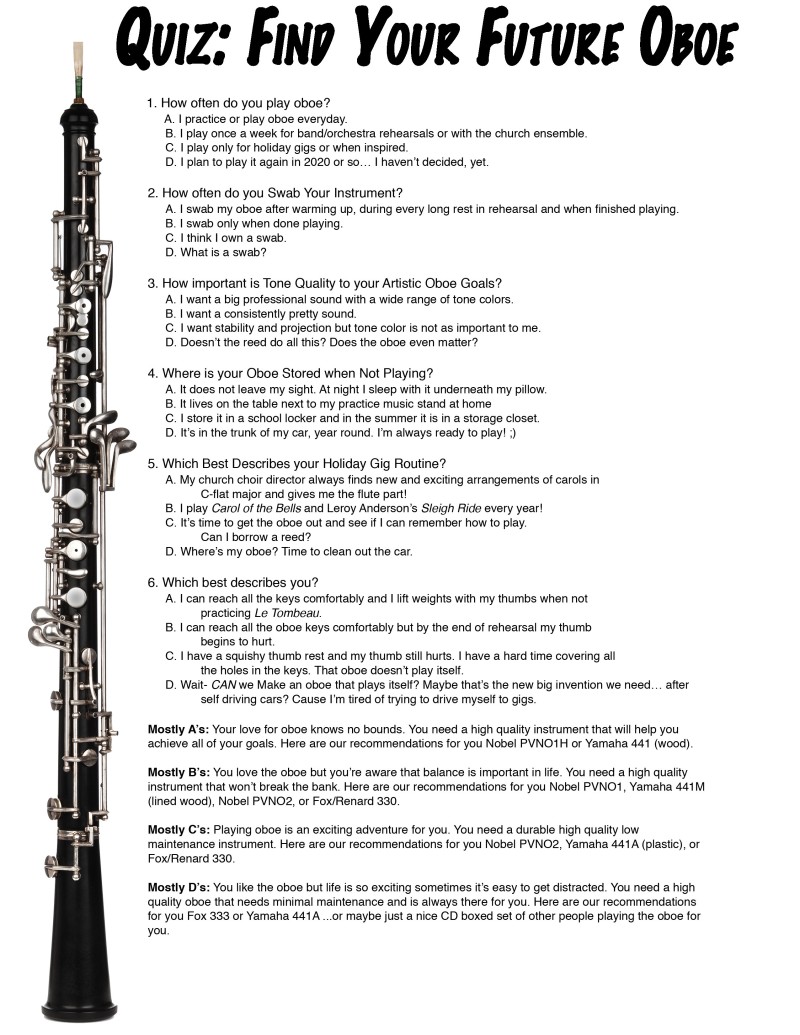
Still not sure we’ve suggested the Best Oboe for Your Music Adventures? We’ve got a Handy Flow Chart that Guarantees you Find the Best Match.
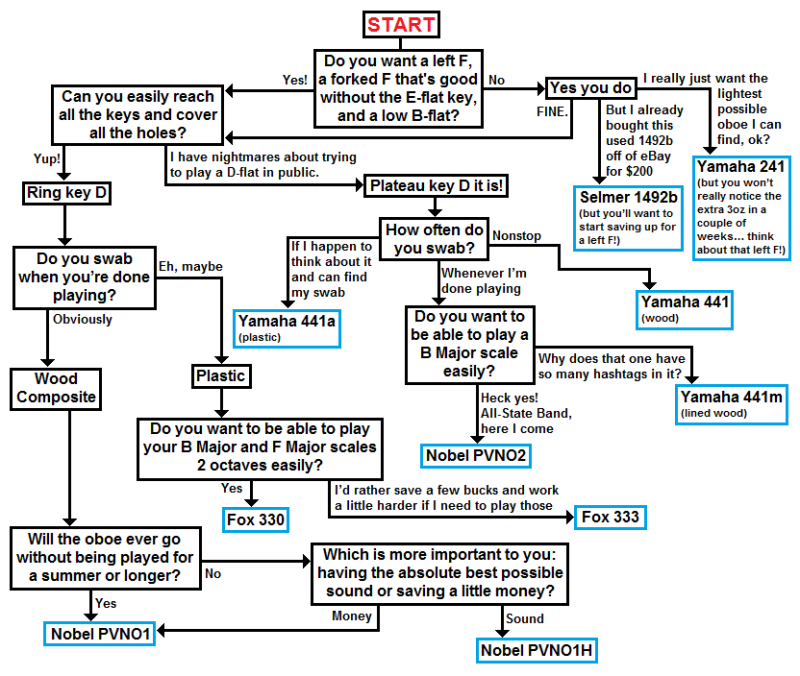
I think it is safe to say we’ve given the New Nobel Oboes a Great Recommendation as an option for your next instrument.
We especially liked that Miller Marketing allowed for upgrades as a student progressed. There is the option to return a Nobel Oboe and put the money towards the next level oboe if you outgrow your current instrument. This is great for students that need to start on the PVNO2 due to smaller hands but as they progressed in their oboe journey they would do better on the PVNO1 or PVNO1H.
As we were reviewing the Nobel Oboes the only aspect we didn’t love was the reed case. Our initial thought was… the instrument price point was so good, one could overlook this deficiency as it offered you the freedom to buy any reed case you liked best.

But after speaking with Justin Miller at Miller Marketing we have created a few upcoming upgrades. Within the next 3-4 months the Nobel Oboes will be upgraded to include a Leather Bound 3 Reed Case!
I love when a company listens to suggestions! 🙂
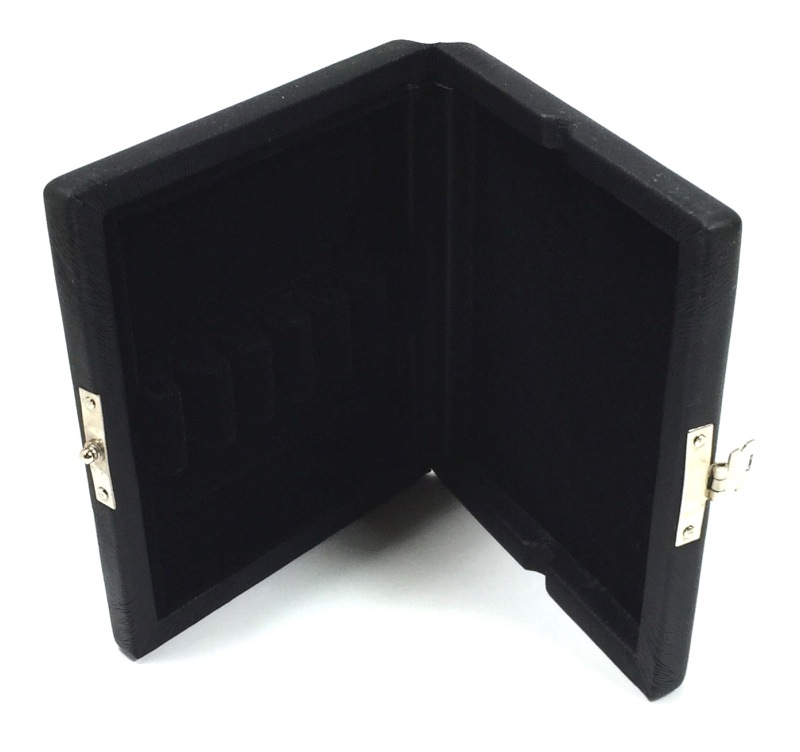
Other upcoming alterations include a New Instrument Case (different than the one pictured in the YouTube video) and updated Zippered Shearling Case Cover.
The Updated Padded Shearling Case Cover includes a Handle and a Pocket for Accessories.
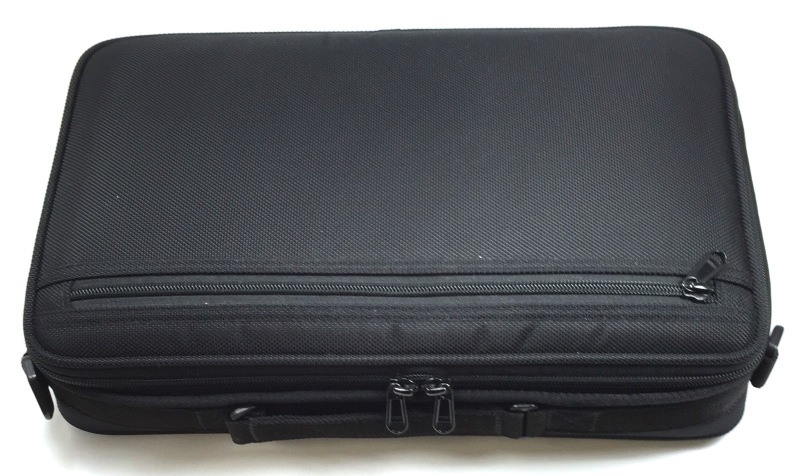
Speaking of Accessories- We loved that the Nobel Oboes came with a double end silk swab!

AND NOW … as promised … let’s dig into a detailed discussion on ALL Those KEYS. Then we will follow up with a discussion of Instrument Body Types.
Hopefully the following details will help Music Educators, College Class Woodwind Students and Parents gain a greater understanding of the needs of Beginner Oboists and find the best long term instrument match.

Erica takes us through a detailed analysis of Oboe Keys, Why You (as a beginner) Want Them, and Which Instruments on the Market Have Them.

Left F
What it does: Sounds identical to regular F but is playable next to notes that use the 3rd finger of the right hand (C#, D, Eb, etc) and makes it much easier to get cleanly from E to F in passages where it’s not possible to use regular F.
Which Instruments Have It: All Nobel oboes, Fox 333 and 330, Yamaha 441.
Which Instruments Don’t Have It: Selmer 1492b, Yamaha 241.

Forked F resonance key
What it does: Opens a small vent on the side of the oboe when playing forked F, making it unnecessary to add the Eb key for timbre and pitch. Forked F without the Eb key on an oboe that doesn’t have a resonance key is so stuffy that you’ll probably wonder if something is broken on your oboe! Unfortunately, most oboes that don’t have a left F don’t have the forked F resonance key, either.
Which Instruments Have It: All Nobel oboes, Fox 333 and 330, Yamaha 441.
Which Instruments Don’t Have It: Selmer 1492b, Yamaha 241.

Low Bb key (with resonance key)
What it does: Lets you play a low Bb without trying to cover the holes in the bell with your knees! The one positive thing about not having a low Bb is that it’s very difficult to accidentally bend the pinky key assembly to the point that it doesn’t work on an oboe without a Bb. But… you can’t play a low Bb. No 2-octave scales for All-State, no Sleigh Ride. The resonance key is the small extra pad on the bell – it isn’t necessary to have this to play a low Bb, but it will make it easier, especially for younger players, to get a good sound on the Bb and not have it come honking out twice as loud as all the other notes on the oboe. Yamaha 441s, Fox 333s, and older Fox 330s have a low Bb but no resonance key.
Which Instruments Have It: All Nobel oboes, Fox 333 and 330, Yamaha 441.
Which Instruments Don’t Have It: Selmer 1492b, Yamaha 241.

Ab-Bb trill key
What it does: Lets you trill from Ab to Bb. This trill is impossible to play without this key. Oboes without this trill key will generally have a solid A key rather than one with a hole in it; occasionally young students with very small hands may have a hard time covering this hole, but that’s pretty rare.
Which Instruments Have It: All Nobel oboes, Fox 333 and 330, Yamaha 441.
Which Instruments Don’t Have It: Selmer 1492b, Yamaha 241.

Open/Split-ring D key (D#-E trill)
What it does: Lets you trill from D#-E more easily and makes it easier to slur to high D. On the Selmer 1492b and Yamaha 241, the E is noticeably more resistant and muffled than its neighbors because there isn’t a hole in the key. While the Nobel PVNO2 doesn’t have an open ring, the manufacturers have obviously compensated for it because the E matches well. The same is true of the Yamaha 441. It’s fairly common for 6th graders who haven’t had a growth spurt yet to have some trouble covering the hole in this key.
Which Instruments Have It: Nobel PVNO1 and PVNO1H.
Which Instruments Have A Single Ring: Fox 333 and 330.
Which Instruments Don’t Have It: Nobel PVNO2, Selmer 1492b, Yamaha 241 and 441.

Articulated low C# (low B-C# trill)
What it does: Makes it possible to trill from low B to C# and to play the low B using the C# key instead of the C key (very helpful for playing the bottom octave of the B Major scale).
Which Instruments Have It:All Nobel oboes, Fox 330.
Which Instruments Don’t Have It: Fox 333, Selmer 1492b, Yamaha 241 and 441.

G#-A trill key (curlicue key)
What it does: Lets you trill more easily from G#-A. Oboes without this trill key will generally have a solid G key rather than one with a hole in it; some young students with very small hands may have to work a bit at covering this hole, but it’s generally a manageable problem.
Which Instruments Have It: Nobel PVNO1 and PVNO1H, Fox 333 and 330.
Which Instruments Don’t Have It: Nobel PVNO2, Selmer 1492b, Yamaha 241 and 441.

Low C-Db trill key (banana key)
What it does: Lets you trill from low C to Db. While I’m a fan of completeness and having all the keys to do the job, I have to be honest with you guys: I’ve been playing professionally for over a decade and in all that time in addition to my time in school, I have needed this key exactly once. 2nd Oboe on Dvorak Slavonic Dance Op. 72, No. 5, y’all. It was a very exciting day!
Which Instruments Have It:Nobel PVNO1 and PVNO1H, Fox 330.
Which Instruments Don’t Have It: Nobel PVNO2, Fox 333, Selmer 1492b, Yamaha 241 and 441.

Third Octave Key
What it does: helps with response and pitch in the extreme upper register (3rd ledger line E and above). These notes are playable without the 3rd octave key and aren’t generally necessary until at least halfway through high school unless the student is really motivated to play a bunch of 2-octave scales for All State. Older Fox 330s do not have a 3rd octave key.
Which Instruments Have It: Nobel PVNO1 and PVNO1H, Fox 330.
Which Instruments Don’t Have It: Nobel PVNO2, Fox 333, Selmer 1492b, Yamaha 241 and 441.
It’s important to note that the Instrument Body Type alters the Sound and Potential for Cracks. So let’s chat about Oboe Body Types!

There are 4 basic different body types of oboes out there: plastic, wood, lined wood, and wood composite, each with some positives and negatives.
PLASTIC is very low-maintenance and lightweight. It can handle being left in an un-air-conditioned band room all summer and it won’t suffer major damage if a student accidentally leaves it in the car overnight in February in Michigan or August in Alabama. For students who are just starting out, supporting the weight of the instrument on the thumb for any length of time is a challenge at first. Even the very light Selmer 1492b still clocks in at 529g or 1 lb 2.65oz. The downside is that the sound is much thinner and less complex, particularly on a thinner-walled instrument. The Fox 330 weighs in at 626g or 1 lb 6.1oz– it has a richer sound than the truly beginner oboes, but it still doesn’t have as full of a sound as a wooden oboe.
LINED WOOD is a wooden oboe with a plastic sleeve inside the bore and lining the tone-holes. The Yamaha 441 offers this as an option. It won’t crack under normal circumstances since the moisture of the breath isn’t coming in contact with the wood, but it is still possible under extreme conditions. The good news is that if it cracks, it won’t go all the way through the bore since the inside is plastic. It’s heavier than just plastic but lighter than just wood, and is somewhere in between those two in terms of sound.
WOOD COMPOSITE is made of grenadilla wood like other wooden oboes, but the wood is ground into dust and then reformed using an epoxy rather than being one solid piece of wood. Wood composite comes the closest to just plain wood in terms of sound quality but won’t crack like a wooden oboe. As with the plastic oboes, the thickness of the walls of the instrument has an effect on the sound: the PVNO1, at 642g or 1 lb 6.60 oz, does offer a fuller sound than the 620g or 1 lb 5.85oz PVNO2… but that extra weight may not be ideal for a student who is just starting out.
WOOD is the material of choice for professional oboes for a reason: it sounds the best. But… it’s heavy, and it can (and probably will) crack. Cracks in oboes are repairable up to a point, but the repair bill is probably going to be at least $500. Most younger students aren’t going to realize the oboe has cracked until it’s gotten pretty bad. If the crack goes all the way through to the bore, the instrument may occasionally not seal even after it’s been pinned. Cracks that go through toneholes require plastic inserts to be put in those toneholes… which is likely to put your repair bill closer to $1000. Any changes in temperature or humidity or failure to swab out the instrument frequently enough can cause an oboe to crack. Sometimes it’s just an unstable piece of wood and it’s going to crack no matter how carefully you take care of it. For those reasons, I would absolutely not recommend an unlined wood instrument to a band director looking to purchase a school instrument.
It is worth noting that the vast majority of cracks in oboes happen in the upper joint—which is why the PVNO1H features a composite top joint—but cracks can and do occasionally happen in the lower joint, particularly if the instrument is subjected to summers in a band locker or quick temperature changes when a student comes in from walking to school in the snow and immediately sits down to play in a warm and very dry band room. More advanced students who are willing to put in the extra effort to care for a wooden instrument will absolutely benefit from the sound of the wood, though, and a new wooden instrument will come with a crack warranty for the first year, which is when most cracks occur.
Note that an older wooden instrument that has been unused for a period of time is more likely to crack in its first few months of reuse than an instrument of the same age that has been played regularly.
No Oboe is complete without a Great Hand Made Reed. If you liked the sound clips in the Youtube video, consider ordering a handmade reed from Erica! To purchase, send her an email at oboeeh AT gmail DOT com. Each handmade reed is $20 plus the cost of shipping, easily purchased via PayPal.
I hope you have found this informative and helps you find the right oboe for your musical adventures. Be sure to join us next week for a full review of English Horns and then later for Nobel Bassoons!





As a parent of an enthusiastic new oboe player, paying rental fees every month and trying to decide what would be our wisest first purchase investment ….I thank you for this incredible informative and helpful post! I feel much more equipped in making our decision!
LikeLike
I am so happy it helped! I’d love to hear which one you end up choosing in the end. Glad to be part of your family oboe adventures. 🙂
LikeLike
Thank you for this excellent explanation. I really appreciate all the detail. I contacted Miller today and have a PVN01 coming on trial. Exciting! I went through my daughter’s school loaner Renard with her and it looks like it has all the key work except 3rd octave and Bb resonance, and the split ring d (it has a hole so a single ring?). I understand that may require some adaptation but hoping the transition won’t be too daunting for her. Your site is a great resource.
LikeLike
Thank you so much for taking the time to leave me a comment. I can’t wait to hear how the PVN01 works out for your daughter, please keep me posted! Best to your family’s oboe adventures. 🙂
LikeLike
Just to follow up, the PVN01 we tried didn’t make too good of a first impression. I was told it was slightly out of adjustment and the G and the A in the upper joint were low in pitch causing intonation issues. We decided to keep looking. Justin Miller was very helpful and professional and the trial was a good experience, but I guess the particular instrument was seen to have some challenges. Thanks again for the educational posting!
LikeLike
Hi Chris, Great to hear from you. My students have had their instruments sent directly to Erica so that all the adjustments required post shipping are taken care of before they try the instruments. This is a challenge with buying all oboes- regardless of brand. I am sure you guys will find the oboe that fits the desires of you and your daughter! Best Wishes to you both!
LikeLike
Maybe I’m too late, but I couldn’t get your code to work for the discount? Also, I don’t see the model numbers on their website. Is the PVN01 the same as the Nobel Mistral Wood Composite Oboe? It’s possible they’ve changed some things on their website since your original posting. Any clarification would be appreciated. Thanks!
LikeLike
You’re NOT too late. The Nobel website was built 6 months after this post. The code is different on their website than on phone or email. FOR THE WEBSITE USE THE CODE: eryno
The Mistral Nobel is the same as the PVN01. The only difference is the logo on the bell of the oboe.
If the code doesn’t work, please let me know and we will find a way around it. There is no need to pay full price.
LikeLike
I have never heard of a Nobel oboe, so it must be new, as they said. I have a Fox 450, wood, with an upper plastic top joint because my community band frequently played outdoors and I also did not need to away from the band with repairs. I would say look a little further into Profession oboe brands and see what their entry oboe is like. Middle School may be fine with plastic oboes. Even some of these keys, except the left hand F are not a huge deal to students. #3rd octave is not either. Find out who sells and is going to maintain your oboe and do repairs. I hope Nobel is not expecting China to do repairs. Fox is American. other oboes are more classic and are made by other countries, but dependable repairmen can be found in the U.S, but are hard to find. China would worry me. I’m not too sure resell on Nobel brand, since no has ever heard of it will resell, except to another younger student. Google the major Music Stores and Dealers in the U.S. for more brands and trial periods. They do exist. Better school systems will provide your student with an oboe. Frequently, the student will be in late high school before they begin to need a Professional, all wood oboe with a name brand for their own. Even then, the choice will be difficult. Borrow six at one time on trial for one week and test all six at home against the others and you will feel better about your selection and the investment, which can last for 20 years or more.
LikeLiked by 1 person
Your video and all of the information helped me to get back into music! I went to that site and purchased an oboe, reeds, and the new reed case. I used to play the Bb clarinet in all of my schooling and have always wanted to learn the oboe. So encouraged to learn after watching your (with Erica Howard) videos. Thanks so much!
LikeLike
Where can i find them? The nobels? I’ve looked online and they don’t seem to exist, do you have a store that I could buy them from?
LikeLike
Hi there- You can find them at https://nobelinstruments.com/
LikeLike